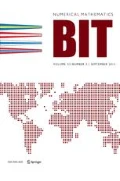Abstract
In this paper, we present concurrency control schemes, based on the optimistic approach, which aim at reducing the rate of rollbacks, tolerating higher degrees of conflict among transactions, and allowing more concurrency at the update phase. Both the single site and fully duplicated database networks are considered. Performance results of the proposed approach are presented. The protocols offer a good tool to improve the throughput of optimistic concurrency control methods and to widen their scope of applicability.
Similar content being viewed by others
References
P. Bernstein, D. Shipman and B. Rothnie,Concurrency and control in a system for distributed database, ACM TODS, Vol. 5, No. 1, March 1980, pp. 18–51.
P. Bernstein and N. Goodman,Concurrency control in distributed database systems, ACM Computing Surveys, Vol. 13, No. 2, June 1981, pp. 185–122.
P. Bernstein, V. Hadzilacos and N. Goodman,Concurrency Control and Recovery in Database Systems, Addison-Wesley, 1987.
H. Boral and I. Gold,Towards a self adapting centralized concurrency control algorithm, ACM SIGMOD, Boston, MA, June 1984, pp. 18–31.
M. Carey,Modeling and evaluation of concurrency control algorithms, Ph.D. Thesis, University of California at Berkeley, 1983.
M. Carey and M. Stonebraker,The performance of concurrency control algorithms for database management systems, Proc. VLDB, 1984, pp. 107–118.
W. Cheng and G. Belford,Update synchronization in distributed databases, Proceedings VLDB, 1980, pp. 301–308.
K. Eswaran, J. Gray, R. Lorie and I. Traiger,The notions of consistency and predicate locks in a database system, CACM, Vol. 19, No. 11, Nov. 76, pp. 624–633.
H. Kung and J. Robinson,On optimistic methods for concurrency control, ACM TODS, Vol. 6, No. 2, June 1981, pp. 213–226.
W. Lin and J. Nolte,Basic timestamp, multiple version timestamp, and two-phase locking, VLDB, Florence, Italy, Oct. 1983, pp. 109–119.
P. Peinl and A. Reuter,Empirical comparison of database concurrency control schemes, VLDB, Florence, Italy, Oct. 1983, pp. 97–108.
M. Reimer,Solving the phantom problem by predicative optimistic concurrency control, VLDB, Florence, Italy, 1983, pp. 81–88.
G. Schlageter,Optimistic methods for concurrency control in distributed database systems, VLDB, Cannes, France, Sept. 1981, pp. 125–130.
A. Silberschatz and Z. Kedem,A family of locking protocols for database systems that are modeled by directed graphs, IEEE Trans. on Software Engineering, Vol. SE-8, No. 6, Nov. 1982.
R. Thomas,A majority consensus approach to concurrency control, ACM TODS, Vol. 4, No. 2, June 1979, pp. 180–209.
Author information
Authors and Affiliations
Rights and permissions
About this article
Cite this article
Bassiouni, M.A., Khamare, U. Algorithms for reducing rollbacks in concurrency control by certification. BIT 27, 441–457 (1987). https://doi.org/10.1007/BF01937270
Received:
Revised:
Issue Date:
DOI: https://doi.org/10.1007/BF01937270




